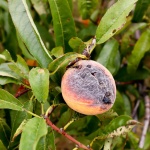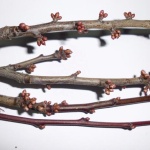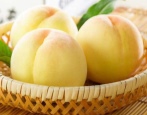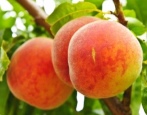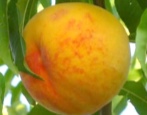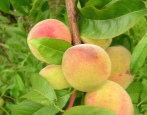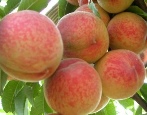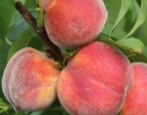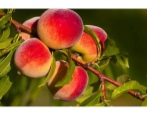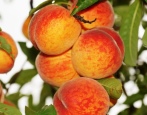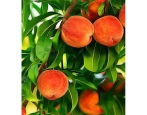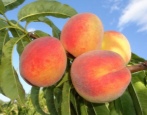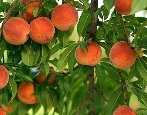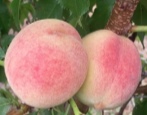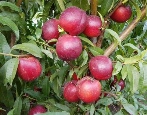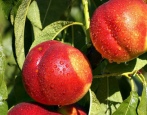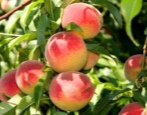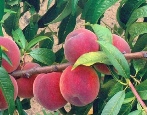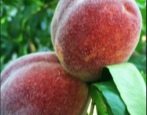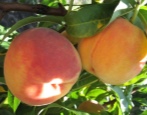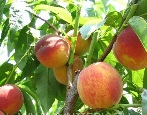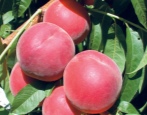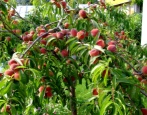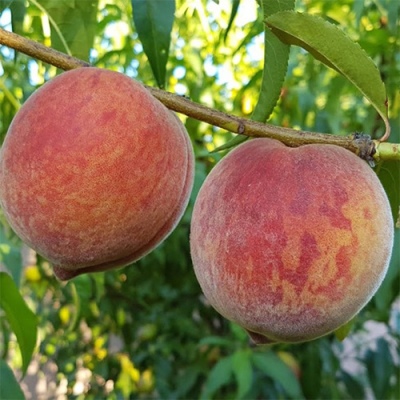
- Authors: America
- Growth type: medium-sized
- Ripening period: early
- Appointment: for fresh consumption, for canning
- Yield: high
- Marketability: high
- Transportability: Yes
- Early maturity: in the second year after planting
- Separability of the bone from the pulp: separates well
- Winter hardiness: increased
Peach of American selection Condor has been known to gardeners for over 20 years. The variety has established itself not only with high yields and delicious fruits, but also pleased with its unpretentiousness in care and resistance to most of the diseases inherent in the culture.
Description of the variety
The maximum plant height reaches 4 m. The variety has a rather spreading crown, but not dense, which makes harvesting easier. Leaves are medium in size, predominantly light green in color with slight ribbing. Condor has good varietal characteristics, since bitter almonds are used as a rootstock. Inflorescences are solitary, pale pink. The advantages of the Condor include:
- high quality fruit;
- high resistance to disease;
- frost resistance and drought resistance;
- high productivity.
Among the disadvantages, gardeners note:
- excessive spreading of the crown and the need for regular pruning;
- overripe fruits can change their taste for the worse.
Fruit characteristics
The fruits are large. On average, the mass of one peach can reach 200 g or more. Their shape is even, rounded. The color of the fruits is yellow, but as they ripen, they are covered with a bright red blush almost over the entire surface of the rind. The skin is quite dense and slightly drooping, with a delicate golden-orange tint.
Due to the fact that the structure of the skin is quite hard, the fruits tolerate transportation very well. But so that the fruits do not lose their presentation, it is still recommended to transport them in special boxes with parchment paper.
Taste qualities
Peach Condor has a sweet taste, light acidity gives the aftertaste bright fruity notes. Orange-yellow flesh with red veins. The consistency is dense and juicy. The bone is easily separated from the pulp.
The fruits are consumed both fresh and processed. They are used to prepare fillings for muffins, pies, puffs, cakes, make the most delicate preserves, jams, fragrant compotes, juices and more.
Ripening and fruiting
The variety belongs to the early ripening period. You can eat peaches in mid-July. The tree begins to bear fruit 2 years after planting.
Yield
The first year the tree does not give a crop, single peaches can be noted. With each subsequent year, the indicators will increase. 10-year-old specimens are capable of producing from 50 to 100 kg. Beginning at the age of 20, the yield decreases: from 50 to 80 kg.
Self-fertility and the need for pollinators
The plant is self-pollinated. There is no need to plant pollinating trees nearby.
Growing and care
The most favorable time for planting a peach is autumn. Planting work must be carried out a month before the onset of frost. During this time, the seedling will have time to grow roots in order to successfully overwinter.
The landing site is chosen as sunny as possible and protected from cold winds. A place near the fence on the south side would be ideal. When growing a peach, it should be borne in mind that a lack of light leads to a poor harvest and tasteless fruits.
Also, you should not plant the tree next to other fruit crops, such as cherries or apricots. They grow very sprawling and can heavily shade the peach.The part of the Condor that has found itself in the shadow will gradually become naked, which leads to a weakening of the immune system.
Peach grows well on loamy and sandy loam soils with a neutral pH. The highest yields on humus-rich soils.
Despite the fact that the Condor peach perfectly tolerates hot weather, watering is carried out 1 time in 2 weeks, at the rate of 40-50 liters per 1 tree. The frequency of irrigation is increased if a prolonged drought is established. Lack of moisture in the soil leads to loss of yield (the tree begins to shed fruits, trying to retain precious moisture in the leaves, shoots and roots).
Waterlogging the soil should also not be, this can lead to the development of fungal infections. Watering is minimized during the ripening period of the fruit.
The variety responds positively to the application of organic and mineral fertilizers. In the spring, with the beginning of budding, the soil is enriched with ammonium nitrate (this will allow the tree to gain good green mass). Phosphorus accelerates flowering and fruit setting. Potassium strengthens the immune system.
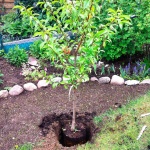
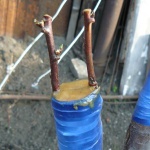
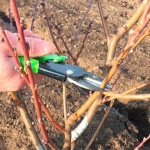
Disease and pest resistance
Peach Condor has strong immunity to most fungal and bacterial infections. For prophylaxis, in the spring, the trunk, branches and shoots are sprayed with a solution of copper sulfate. In summer, trees are affected by aphids, weevils, and ticks. Pests are fought with fungicides and insecticides.
